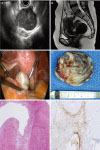1. Wharton LR. Two cases of supernumerary ovary and one of accessory ovary, with an analysis of previously reported cases. Am J Obstet Gynecol. 1959; 78:1101–1119.
2. Winckel F. Lehrbuch der Frauenkrankheiten. 2nd ed. Leipzig: S. Hirzel;1890.
3. Irving JA, Clement PB. Nonneoplastic lesions of the ovary. In : Kurman RJ, Ellenson LH, Ronnett BM, editors. Blaustein's pathology of the female genital tract. Boston (MA): Springer;2011. p. 579–624.
4. Lachman MF, Berman MM. The ectopic ovary. A case report and review of the literature. Arch Pathol Lab Med. 1991; 115:233–235.
5. Printz JL, Choate JW, Townes PL, Harper RC. The embryology of supernumerary ovaries. Obstet Gynecol. 1973; 41:246–252.
6. Imir G, Arici S, Cetin M, Kivanc F. Supernumerary ovary on sigmoid colon resembling an endometriotic lesion. J Obstet Gynaecol Res. 2006; 32:613–614.

7. Badawy SZ, Kasello DJ, Powers C, Elia G, Wojtowycz AR. Supernumerary ovary with an endometrioma and osseous metaplasia: a case report. Am J Obstet Gynecol. 1995; 173:1623–1624.
8. Ogishima D, Sakaguchi A, Kodama H, Ogura K, Miwa A, Sugimori Y, et al. Cystic endometrioma with coexisting fibroma originating in a supernumerary ovary in the rectovaginal pouch. Case Rep Obstet Gynecol. 2017; 2017:7239018.

9. Lim MC, Park SJ, Kim SW, Lee BY, Lim JW, Lee JH, et al. Two dermoid cysts developing in an accessory ovary and an eutopic ovary. J Korean Med Sci. 2004; 19:474–476.

10. Levy B, DeFranco J, Parra R, Holtz P. Intrarenal supernumerary ovary. J Urol. 1997; 157:2240–2241.

11. Kriss BR. Neoplasm of a supernumerary ovary; report of two cases. J Mt Sinai Hosp N Y. 1947; 14:798–801.
12. Hogan ML, Barber DD, Kaufman RH. Dermoid cyst in supernumerary ovary of the greater omentum. Report of a case. Obstet Gynecol. 1967; 29:405–408.
13. Huhn FO. Dermoid cysts of the greater omentum (author's transl). Arch Gynakol. 1975; 220:99–103.
14. Roth LM, Ehrlich CE. Mucinous cystadenocarcinoma of the retroperitoneum. Obstet Gynecol. 1977; 49:486–488.
15. Cruikshank SH, Van Drie DM. Supernumerary ovaries: update and review. Obstet Gynecol. 1982; 60:126–129.
16. Mercer LJ, Toub DB, Cibils LA. Tumors originating in supernumerary ovaries. A report of two cases. J Reprod Med. 1987; 32:932–934.
17. El-Gohary Y, Pagkratis S, Lee T, Scriven RJ. Supernumerary ovary presenting as a paraduodenal duplication cyst. J Pediatr Surg Case Rep. 2015; 3:316–319.

18. Barik S, Dhaliwal LK, Gopalan S, Rajwanshi A. Adenocarcinoma of the supernumerary ovary. Int J Gynaecol Obstet. 1991; 34:75–77.

19. Besser MJ, Posey DM. Cystic teratoma in a supernumerary ovary of the greater omentum. A case report. J Reprod Med. 1992; 37:189–193.
20. Kamiyama K, Moromizato H, Toma T, Kinjo T, Iwamasa T. Two cases of supernumerary ovary: one with large fibroma with Meig's syndrome and the other with endometriosis and cystic change. Pathol Res Pract. 2001; 197:847–851.






 PDF
PDF ePub
ePub Citation
Citation Print
Print



 XML Download
XML Download